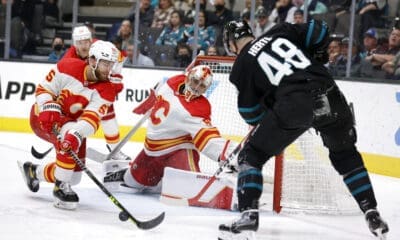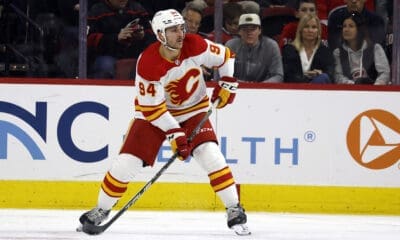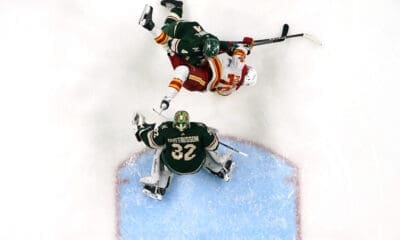Calgary Flames
Systems Looks – Penalty Kill Part 1
Today we're going to briefly look at some examples of success on the penalty kill and why the Flames PK has had success this year.

Special teams can make or break any organization for the most part. These are heavily luck driven intervals of time where just about anything can happen, good or bad. Calgary's utilization of an aggressive defense, abundant with shot blocks, when down a man is one of the more exciting aspects of their season.
A lot of this series is driven by re-reading Jen LC's PK Metrics and Pitfalls in Evaluating Success article she did back in February. I recommend it not only because it's great but because Jen's quality of work is among the elite of hockey writers.
Lucky bounces help, too.
Penalty Differential –
This season has been very successful in terms of limiting the number of penalties taken while drawing more. Calgary's penalty differential all season (and all situations) is tops at +66. That includes the recent struggles and it's +11 higher than Chicago in second. However, since the end of February, they've had some ups and downs. Currently their even strength differential has plummeted to +2 only. In all situations they're +10.
Using February 27th (the Flames‘ first game since losing Mark Giordano) as the marking point of when a lot of media, fans, and writers thought the team would crater immediately, Calgary has sustained a remarkably interesting penalty kill. They’ve still managed only seven goals against on 46 PKs. Up until recently, the Flames PenD has been one of the best. Recent games have seen them playing more undisciplined and putting them in situations that hamper their success.
Hartley and the coaching staff need to get the team back on track. Despite them winning games, this is one of the obvious issues impacting the team: especially if you're in the hunt for a playoff position, as you can't find complete success playing 5v4 all night.
Let's take a look at four individual examples of success on the penalty kill. We're going to start with the Flames kill against Dallas. All these examples showcase the strengths that have been used to find success and even score a few goals.
Example One: Four minute kill vs Dallas on March 25th
To set the stage here, Dallas wins the initial faceoff, allowing them to setup. Jason Spezza is going to pass along the boards to Jamie Benn behind the net.

Calgary is employing their standard diamond-box giving them capability for shot-blocking and enough room to maneuver around their zone.
The pass doesn’t connect properly (it is rather faint in the image), but it allows Dennis Wideman to apply suitable pressure on Benn. TJ Brodie, reading the situation, moves in on Benn and Josh Jooris is aware of John Klingberg heading to the half-wall.
Klingberg fumbles the puck here. Calgary's positioning adjusts as soon as Jooris is on Klingberg. You see a box formation with lateral movement when needed.
Jooris reaches in and forces the puck out allowing for the Flames to force the Stars back into their own zone.
Closing notes on this sequence:
- Josh Jooris has been doing this a lot of the season; Paul Byron, too. Aggressive, but logical play is the key here.
- Positioning in their zone never really changed. This is a great example of the Flames being able to read the play effectively while not falling out of position.
- It all starts with Dennis Wideman being smart about the sequence.
Example Two: Zone clear during four minute kill
Another brief example of how to get the puck down the ice and applying proper pressure can kill time. The Stars at this point are struggling with finding quality chances, quality shots, and sustained zone time. They head back up ice and dump the puck in.
This allows the Flames to clear the zone and then in their own end, the Stars give up the puck allowing them to kill enough time to force them to regroup.
Against the Predators on March 29, the Flames hindered Nashville's high slot positioning, play along the boards, and the neutral zone for clean entries. Here you see why preventing plays from setting up is key to success. You also see a bit of the neutral zone play that made it harder to enter the zone cleanly.
Key points to take from this:
- At the beginning of the video you see that Mikael Backlund is following the Predators back into their zone. He doesn’t chase around the net but stays aware of the play up the ice.
- Making use of play along the boards allows the Flames to clear the zone. They’re also able to follow up to the Preds’ blue line.
- Neutral zone trapping Colin Wilson into not cleanly entering the zone, causing a turnover which sends the puck up the ice again.
Example Four: Scoring shorthanded goals against the Leafs on March 13th
Discussing the penalty kill without looking at the Flames' two shorthanded goals against the Leafs would not be fair to the readers. Within those goals are plays and decisions that ultimately sent the Flames up ice to success. The Backlund goal was purely him.
After the puck ends up in the Leafs' end due to Phil Kessel's missed shot you see Backlund head up ice in pursuit of the puck.
As the play continues, he is still hard on the puck trying to gain possession. He is successful in his exploits as the turnover sends him up ice and he makes it 3-1 for the Flames.
Leading into the second SHG against the Leafs, it should be noted that once again the Flames found ways to get on the forecheck and into the offensive zone. A shift by Jiri Hudler and Drew Shore created some zone time after the puck was cleared. Joe Colborne and Backlund also went up ice prior to the Sean Monahan goal.
What stands out most about this situation are the following things:
The Defensive zone faceoff win allows the Flames to set up and prepare for Leafs to potentially get into position for their PP or clear it out. Colborne is situated in a spot where if he needs to block a shot or obstruct the situation he can. He also has room to head to the boards, which he does.
Deryk Engelland's work behind the net is so crucial here. It gives TJ Brodie room to move the puck up ice and spring Monahan up the ice. Keep in mind Monahan has now moved to where Colborne was. Brodie is clearly aware that he has an opportunity to move the puck and takes it.
Being aware of what is happening is the final piece to this play working. Monahan knows that Brodie has enough time to clear it or pass it. He's watching for the pass and he's alert of how much room he has to move. The saucer-pass is so key to this play succeeding. The Leafs almost prevent it, too.
Honesty
It should be noted that the Flames' PK isn't always perfect. The recent games against Dallas have HUGE examples of why there are some gaps and opportunities to build on. We'll touch on that in a separate post as there are great examples of things that need slight adjustments and issues that have existed all season that have yet to be resolved.
by Mike Pfeil








